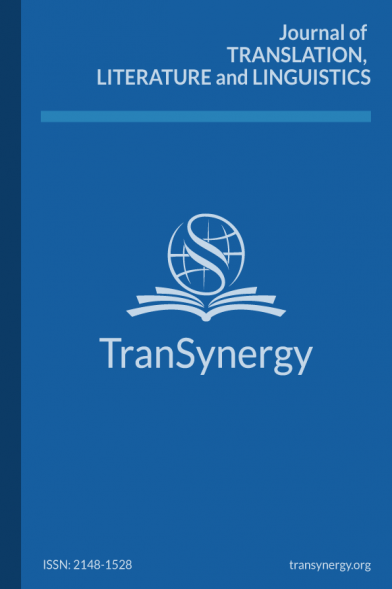The Interplay Between Public Diplomacy and Interpreting in The Light of Interpretive Theory of Translation (Theory of Sense)
Public diplomacy, soft power, interpreting, simultaneous interpreting, interpretive theory of translation
The Interplay Between Public Diplomacy and Interpreting in The Light of Interpretive Theory of Translation (Theory of Sense)
Public diplomacy, soft power, interpreting, simultaneous interpreting, interpretive theory of translation,
___
- Angelelli, C. V. (2004). Revisiting the interpreter’s role. John Benjamins Publishing Company.
- Aydemir, E. (2018). Kamu diplomasisi. Kalkedon.
- Baigorri-Jalon, J. (1984). From Paris to Nuremberg: The birth of conference interpreting. John Benjamins Publishing Company.
- Baranyai, Tamas (2011). The role of translation and interpretation in the diplomatic communication. SKASE Journal of Translation and Interpretation [online]. 5, (2).
- Bogg, E. (2015). Interpreting U.S. public diplomacy speeches. Frank and Timme.
- Chesterman, A. (2009). The name and nature of translator studies. Hermes. Journal of Language and Communication in Business, 22(42), 13–22.. //doi.org/10.7146/hjlcb.v22i42.96844
- Creswell, J. W. (2014). Research design: qualitative, quantitative and mixed methods approaches (4th ed.). Sage.
- Çakır, F. & Tekin Çetin H. (2022). Sosyolojik eksende kültürel diplomasi ve çeviri. RumeliDE Dil ve Edebiyat Araştırmaları Dergisi , (26), 1155-1190. 10.29000/rumelide.1074134.
- Delisle. J. (1980). Analyse du discours comme méthode de traduction: à la tmduction française de textæs pragmatiques anglais. Edition de l’Université d’Ottawa.
- Delisle, J. & Woodsworth, J. (eds.). (2012). Translators through history. Benjamins Translation Company.
- Denzin, Norman K., & Lincoln, Yvonna S., (eds.) Strategies of qualitative inquiry. Third Edition Sage Publications.
- Diriker, E. (2005). Konferans çevirmenliği: Güncel uygulamalar ve araştırmalar. Scala Yayıncılık.
- Diriker, E.. (2009) Meta-discourse as a source for exploring the professional image(s) of conference interpreters. Hermes: Journal of Language and Communication Studies, 42, Aarhus: Aarhus School of Business, 71-91.
- Doğan, A. (2009). Sözlü çeviri çalışmaları ve uygulamaları. Hacettepe Yayınları.
- Durukan, E. & Çokövün, (2015) Gile’in IDRC modeli temelinde yorumlayıcı anlam kuramının değerlendirilmesi. İ.Ü. Çeviribilim Dergisi, 10 (2), 29-50.
- Göktaş, N. (2014). Yorumlayıcı çeviri kuramı’ndan çeviri eğitimine: Yorumlayıcı çeviri yöntemi. Diyalog, 2, 46-60.
- Gurgu, E. & Cociubran, A. D. (2016). The role of public diplomacy in international relations in full process of globalization. Annals of Spiri Haret University Economic Series, (2) 125-141.
- Gürçağlar, Ş. (2011). Çevirinin ABC!si. Say Yayınları.
- Haradhan, M. (2018). Qualitative research methodology in social sciences and related subjects. Journal of Economic Development, Environment and People. 1 (7) 23-48.
- Helmer, E. (2019). Smoothening and softening: The Interpreter as an everyday diplomat. Working Papers WP Centre for German and European Studies (CGES)
- Herbulot, F. (2004). La Théorie interprétative ou Théorie du sens : point de vue d’une praticienne. Meta,49 (2), 307–315. https://doi.org/10.7202/009353ar
- İskit, T. (2015). Diplomasi tarihi, teorisi, kurumları ve uygulaması. İstanbul Bilgi Üniversitesi Yayınları.
- Junghwa, C. (2003) The interpretive theory of translation and its current applications. http://jaits.jpn.org/home/kaishi2003/pdf/01-choi_final_.pdf
- Kalın., İ. (2011). Soft power and public diplomacy in Türkiye. Perceptions, (XVI), 3. 5-23
- Kang, Qiang (2013). Application of the interpretive theory of translation in interpreting practice. Canadian Social Science, 9 (6), 236-241. http://dx.doi.org/10.3968/j.css.1923669720130906.2903.
- Karakoç, N. Y. (2015). Çeviri ve diplomasi. Çeviribilim.
- Lederer, M. (2006). La théorie interprétative de la traduction. Origine et évolution. Qu’est-ce que la traductologie, Artois Presses université, 37-52.
- Özcan, O. (2019). Yazın çevirisi incelemelerinde yorumlayıcı çeviri kuramı. RumeliDE Dil ve Edebiyat Araştırmaları Dergisi, (16), 587-603. DOI: 10.29000/rumelide.619082
- Pagura, J. R. (2012). A Teoria Interpretativa da Tradução (Théorie du Sens) revisitada: um novo olhar sobre a desverbalização* TradTerm, (19), 92-108 http://tradterm.vitis.uspnet.usp.br
- Pöchhacker, F. (1995). Simultaneous interpreting: A functionalist perspective. Hermes, Journal of Linguistics 14, 31-53. https://doi.org/10.7146/hjlcb.v8i14.25094
- Roland, R. (1999). Interpreters as diplomats. A Diplomatic History of the Role of Interpreters in World Politics. University of Ottawa Press
- Saldanha, G. and O’Brien, S. (2013). Research methodologies in translation studies. Routledge.
- Sawyer, D. B. (2012). The role of Interlingual mediation in public diplomacy: An exploration of research methodologies. Ewha Research Institute for Translation Studies. (2) 31-51. 10.22962/tnirvw.2012.2..002
- Su, J. (2019). The evolution and new dynamics of interpreting studies. U.S.-China Foreign Language, 7 (17), 311-317. https://doi.org/10.17265/1539-8080/2019.07.001
- Yaylar, Y. (2020). Karşılaştırmalı kamu diplomasisi analizi: Türkiye, ABD ve Japonya. Akademisyen Kitabevi.
- Yunyan, Zhu. (2020). Application of the Interpretive Theory of Translation to Business Interpretation. Journal of Educational Issues. 6(1), 127-139. doi:10.5296/jei.v6i1.16709
- ISSN: 2979-9503
- Yayın Aralığı: Yılda 2 Sayı
- Başlangıç: 19.12.2022
Burcu AKPULAT, F. Büşra SÜVERDEM
Neglected Dimension of Lexical Competence in ELT: Metaphorical Competence
The Effects of Subtitles on Language Learning
Selen TEKALP, Serde YERLİKAYA, Sibel POLAT
Kate Chopin’s Desiree’s Baby: A New Historicist Approach
“Observe God in His works”*: Mystical Via Media in Henry Vaughan’s Silex Scintillans
